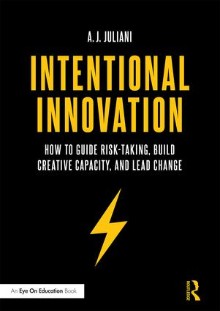Intentional Innovation to Lead Creative Change
Intentional Innovation: How to Guide Risk-Taking, Build Creative Capacity, and Lead Change
By A.J. Juliani
(Routledge/Eye On Education, 2018 – Learn more)

A.J. Juliani lays out the purpose of Intentional Innovation: How to Guide Risk-Taking, Build Creative Capacity, and Lead Change on page 5:
“This book dives into a framework for not only dealing with change in the world, but empowering students, teachers, and staff to thrive in this environment.”

The book is divided into three sections.
Part 1: The Need for Innovation
Part 2: A Framework for Innovation
Part 3: Doing the Work
In Part 1, the author revisits the 4 basic stages of cognitive learning and continues with a discussion of the impact technology is having on our brains. He concludes Chapter 2 by reminding readers that we must “harness the beneficial ways technology can help in the teaching / learning process.” (p.32) Throughout the remainder of the book he offers suggestions and ideas to reach that goal.
In Part 2, he continues to guide readers in the intentional process of change and risk-taking. He introduces and explains how to implement the PLASMA Framework:
- What to Praise, Look For, and Assess
- Support What is Different
- Make Time for Creative Work
- Allow for the New and Unknown
School leaders will find numerous ideas and suggestions that give students opportunities to explore, make, and create. The reader will have to pick and choose from a wide range of activities. I know I would pick “Appeals Day.” At the end of the grading period, Juliani allows students to appeal a grade in a respectful manner. He shares several benefits but concludes that the biggest benefit was “how hard my students collaborated and worked to prepare for Appeals Day.” (p. 110)
As with any change, there will be criticism. In Part 3 he offers practical guidelines for risk-taking along with ideas for celebrating both failing and learning. He offers four thoughts about dealing with criticism: (pp.116-117)
- When you take risks, criticism will follow.
- Don’t dismiss all criticism; take it for what it is.
- Keeping it to yourself is not going to help.
- Add fuel to your creative fire.
He reminds readers that we should not celebrate the failure, “but instead celebrate the act of taking the risk and bouncing back, regardless of the outcome.” (p.129)
As someone who began her teaching career with one piece of technology, a 16mm film projector, I found the book very enlightening. I truly appreciated the author’s statement on page 145: “Let’s stop thinking about technology as a cure or savior for education.” Today’s educators have a plethora of technology at their fingertips; this book guides them to make intentional choices for their classrooms.
School leaders might consider Intentional Innovation as a book study. It’s a book that should cause educators to examine their own beliefs and practices related to technology. Juliani’s grandmother said it best: “The focus on relationships should never change, even if the way to build those relationships does change.” (p. 89)
A free study guide is available here.
Anne Anderson is a retired middle school teacher living in Shreveport, LA. Now she shares her expertise as an educational consultant providing educators with practical solutions to teaching and learning problems. Contact her at anneanderson@bellsouth.net.






























